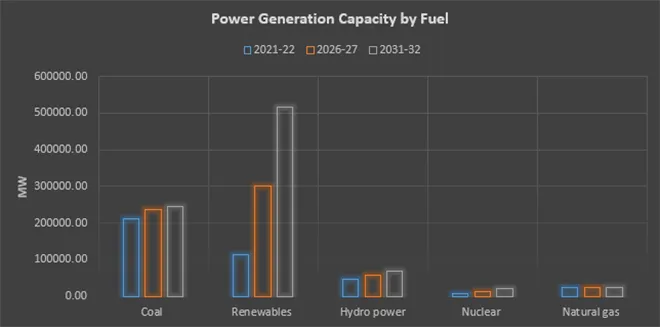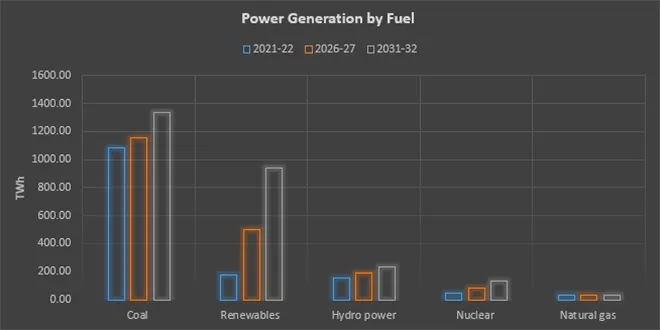 This article is part of the series Comprehensive Energy Monitor: India and the World
This article is part of the series Comprehensive Energy Monitor: India and the World
Current Status: Capacity and Generation
The
draft National Electricity Plan of the CEA (central electricity authority) released in September 2022 (NEP 2022) for public consultation contains a review of developments in 2017-22, detailed capacity addition plans for 2022-27 and projections for 2027-32. Conventional capacity addition in 2017-22 was 30,667 megawatt (MW) which was 40 percent short of the planned capacity addition of 51,561 MW. The primary reason for the shortfall in capacity addition was the lockdown on account of the pandemic. As on 15 September 2022, installed power generation capacity was
404,132.96 MW with coal contributing
210,699.5 MW or 52.14 percent, hydropower contributing
46,850.17 MW or 11.5 percent of total capacity, natural gas contributing
24,856.21 or just over 6 percent of capacity and nuclear energy accounting for 6780 MW equivalent to 1.6 percent of power generation capacity. Renewable energy (
solar, wind, biomass, and other new renewable energy sources) accounted for 114,437.37 MW (in July 2022) or 28.3 percent of capacity, making it the second largest after coal. Coal and natural gas generated 1114.75-terawatt hour (TWh) or 74 percent of power generation in 2021-22 followed by RE which contributed 178.34 TWh or 11.9 percent of power generation. Hydropower contributed 154.64 TWh or 10.36 percent of power generation while nuclear energy contributed 47.110 TWh or 3.15 percent of power generation.'
 Source: Draft National Electricity Plan
Source: Draft National Electricity Plan
Projected Fuel Mix in 2027
The NEP 2022 projects coal-based power generation capacity of 25,580 MW and gas-based power generation capacity of 370 MW that are under constriction to come online by 2027. This would mean that coal-based power generation capacity will increase to 236,279.5 MW but its share in total capacity is expected to fall to 37.9 percent. Capacity addition of 370 MW will marginally increase the share of natural gas in power generation to 6.2 percent. Though 10,903 MW of hydropower capacity is expected to be added the share of hydropower capacity will fall to 9.2 percent by 2027. Around 1580 MW of pumped hydropower capacity is expected to become operational by 2027 while nuclear energy is expected to double in capacity adding 7000 MW and its share in power generation capacity is expected to increase to 2.2 percent. RE is expected to add 187,909 MW of capacity with solar making the largest contribution of 132,080 MW, followed by wind with 40,500 MW. Biomass-based power generation is expected to contribute 2318 MW and pumped storage 2700 MW. The overall share of RE in power generation capacity of 302,346 MW or 48.5 percent will be larger than that of coal if it materialises by 2027. In terms of generation, coal will continue to be the largest with 1158 TWh or 58.8 percent of generation and RE with an anticipated generation of 503 TWh is expected to make up 26.4 percent of total generation by 2027. The share of gas in power generation is projected to remain marginal at 35 TWh or just 1.7 percent and the share of nuclear generation increase to 82 TWh or 4.1 percent. The share of hydropower in generation at 189 TWh is expected to fall marginally to 9.6 percent.
Projected Fuel Mix in 2032
The total power generation capacity is expected to increase by about 40 percent from 622,899 MW in 2027 to 865,941 MW by 2032. The largest capacity addition of 214,020 MW is expected from RE with about 69 percent contributed by solar photovoltaics (PV). Offshore wind power generation capacity of about 10,000 MW is expected to come onstream by 2032. Overall, RE is expected to account for about 60 percent of power generation capacity by 2032 estimated at 516,361 MW. The share of coal-based power generation capacity is expected to fall from about 37 percent in 2027 to 28.3 percent in 2032. No additional gas-based power generation capacity is expected after 2027 and the share of natural gas in power generation is expected to fall to just 2.9 percent by 2032. With 68,641.17 MW the share of hydropower is also expected to fall to 7.9 percent by 2032 (from 9.6 percent in 2027). Projections for nuclear power are optimistic with additional capacity of 8000 MW coming onstream by 2032. This will increase nuclear power generation capacity to 22,480 MW and its share in total power generation capacity is expected to increase to 2.5 percent (from 2.2 percent in 2027). Total power generation is expected to increase to 865,941 TWh by 2032 of which coal is projected to account for the largest share of 1333.8 TWh or about 50 percent. Generation from RE is expected to touch 938 TWh equivalent to 34.8 percent of generation. Generation from hydropower of 231.8 TWh is expected to account for 8.7 percent of total generation in 2032. Generation of 134 TWh of power from nuclear generators is projected to increase to 5 percent of total generation.
Challenges
Projections by the draft NEP 2022 for power generation capacity are in line with the goal of installing 500 GW (gigawatts) of non-fossil-based power generation capacity by 2030. As projected by NEP 2022, overall power generation capacity is expected to increase by over 114 percent in 2022-2032. In this period, RE power generation capacity is expected to increase by over 351 percent, nuclear by over 230 percent, hydropower by over 46 percent, coal by over 16 percent and gas by just 1.5 percent. Though coal-based power generation capacity is expected to slow down, coal will continue to make the largest contribution to power generation even by 2032. This is made possible by increasing the PLF (plant load factor) of coal-based power plants from 55 percent in 2026-27 to over 62 percent in 2031-32. Total carbon-dioxide emissions from power generation is expected to increase from 910 MT (million tonnes) in 2020-21 by about 30 percent to 1180 MT by 2031-32 though the emission factor from power generation is expected to fall to 0.441 kg (kilogram)/kWh (kilowatt hour). Increase in non-fossil fuel-based capacity by 2030 and the consequent decrease in emission factor rest on the substantial increase in RE based power generation and to a lesser extent on nuclear power. RE will require financial resources as well as natural resources such as land and minerals on an unprecedented scale. The key challenge for policy will be to ensure availability of financial and natural resources, redesign the market to accommodate zero marginal cost power from RE and invest in battery and other forms of energy storage to strengthen energy security.
 Source: Draft National Electricity Plan
Source: Draft National Electricity Plan
The views expressed above belong to the author(s). ORF research and analyses now available on Telegram! Click here to access our curated content — blogs, longforms and interviews.



 This article is part of the series
This article is part of the series 

 PREV
PREV




